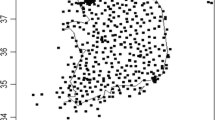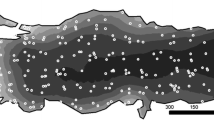Abstract
The measured ozone pollution peak in the atmosphere of Mexico City region was considered in order to study the effect of a non-stationary mean of the sampled data in geostatistics interpolation methods. With this objective the local mean value of the sampled data was estimated through a linear regression analysis of their values on the monitoring station’s coordinates. The residuals obtained by removing the data trend are considered as a set of stationary random variables. Several interpolation methods used in geostatistics, such as inverse distance weighted, kriging, and artificial neural networks techniques were considered. In an effort to optimize and evaluate its performance, we fit interpolated values to sampled data, obtaining optimal values for the parameters defining the used model, that means, the values of the parameters that give the lowest mean RMSE between the interpolated value and measured data at 20 stations at 1500 hours for a set of 21 days of December 2001, which was chosen as the training set. The training set is conformed by all the days in December 2001 excepting the days (3,6,9,12,...,27,30) which were considered as the testing set. Once the optimal model is obtained, it is used to interpolate the values at the stations at 1500 hours for the testing days. The RMSE between interpolated and measured values at monitoring stations was also evaluated for these testing values and is shown as a percentage in Table 2. These values and the defined generalization parameter G, can be used to evaluate the performance and the ability of the models to predict and reproduce the peak of ozone concentrations. Scatter plots for testing data are presented for each interpolation method. An interpretation of the ozone pollution levels obtained at 1500 hours at December 21 was given using the wind field that prevailed in the region 1 h before the same day.




Similar content being viewed by others
References
Barone JB, Cahill RA, Eldred RA, Flocchini RG, Shadoan DJ, Dietz TM (1978) A multivariate statistical analysis of visibility degradation at four California Cities. Atmos Environ 12:2213–2221
Boznar M, Lesjak M, Mlakar P (1993) A neural network-based method for the short-term predictions of ambient SO2 concentrations in highly polluted industrial areas of complex terrain . Atmos Environ B27:221–230
Chilès JP, Delfiner P (1999) Geostatistics, modeling spatial uncertainty. Wiley, New York
Comisión Ambiental Metropolitana (2002) Programa para mejorar la calidad del aire de la Zona Metropolitana del Valle de México 2002–2010, Mexico
Comrie AC (1997) Comparing neural networks and regression models for ozone forecastings . J Air Waste Manage 47:653–663
Cressie N (1991) Statistics for spatial data. Wiley, New York
De Leeuw FAAM, Van Zantvoort EG (1997) Mapping of exceedances of ozone critical levels for crops and forest trees in the Netherlands: preliminary results. Environ Pollut 96:89–98
Diem JE, Comrie AC (2002) Predictive mapping of air pollution involving sparse spatial observations. Environ Pollut 119:99–117
Dowla FU, RogersLL (1996) Solving problems in environmental engineering and geosciences with artificial neural networks. MIT, Cambridge
Falke SR, Husar RB (1996) Uncertainty in the spatial interpolation of ozone monitoring data. http://www.capita.wustl.edu/CAPITA/CapitaReports/O3Interp/O
Gardner MW, Dorling SR (1999) Neural network modeling and prediction of hourly NO x and NO2 concentrations in urban air in London. Atmos Environ 33:709–719
Gardner MW, Dorling SR (1998) Artificial neural networks (The multilayer perceptron)—a review of applications in the atmospheric sciences. Atmos Environ 32:2627–2636
Georgopoulos PG, Seinfeld JH (1982) Statistical distributions of air pollutant concentrations. Environ Sci Technol 16:401A–416A
Gilbert RO (1987) Statistical methods for environmental pollution monitoring. Van Nostrand Reinhold, New York
Goovaerts P (1997) Geostatistics for natural resources evaluation. Oxford University Press, New York
Jacobson MZ (2000) Fundamentals of atmospheric modeling. Cambridge University Press, New York
Kyriakidis PC, Journel AG (1999) Geostatistical space-time models: a review. Math Geol 31:651–684
Leenaers H, Okx J P, Burrough PA (1990) Comparison of spatial prediction methods for mapping flood plain soil pollution. Catena 17:535–550
Liu LJS, Rossini AJ (1996) Use of kriging models to predict 12-hours means ozone concentrations in metropolitan Toronto-a pilot study. Environ Int 22:677–692
Mulholland JA, Butler AJ, Wilkinson JG., Rusell AG (1998) Temporal and spatial distributions of ozone in atlanta: regulatory and epidemiologic implications. Air Waste Manage Assoc 48:418–426
Oran ES, Boris JP (1987) Numerical simulation of reactive flow. Elsevier, New York
Phillips DL, Tingey DT, Lee EH., Herstrom AA, Hogsett WE (1997) Use of auxiliary data for spatial interpolation of ozone exposure in southeastern forest. Environmetrics 8:43–61
Seinfeld JH, Pandis SN (1998) Atmospheric chemistry and physics. Wiley-Interscience, New York
Simpson RW, Layton AP (1983) Forecasting peak ozone levels. Atmos Environ 17:1649–1654
Sistema de Monitoreo Atmosférico de la Ciudad de México, http://www.sma.df.gob.mx/simat/mediciones/
Schmidt W, Raudys S, Kraaijweld M, Skurikhina M, Duin R (1993) Initializations, back-propagation and generalization of feed-forward classifiers. Proc 1993 IEEE Int Conf Neural Networ 1:598–604
Trivikrama SR, Samson PI, Pedadda AR (1976) Spectral analysis approach to the dyanamics of air pollutants. Atmos Environ 10:375–379
Wackernagel H (2003) Multivariate geostatistics. 3rd edn. Springer, Berlin Heidelberg New York
Yi J, Prybutok R (1996) A neural network model forecasting for prediction of daily maximum ozone concentration in an industrialized urban area. Environ Pollut 92:349–357
Acknowledgments
This work has been supported in part by Mexico’s CONACYT under contract Nr. 880146-2. The data and other information used in this work were supplied by the Red Automática de Monitoreo Atmosférico RAMA of Mexico City. We would like to sincerely thank the anonymous reviewers for their helpful comments and suggestions that improved the quality of this manuscript considerably. We thank Mr. Kelley for corrections in the English language which improved the fluidity of the manuscipt.
Author information
Authors and Affiliations
Corresponding author
Rights and permissions
About this article
Cite this article
Rojas-Avellaneda, D., Silván-Cárdenas, J.L. Performance of geostatistical interpolation methods for modeling sampled data with non-stationary mean. Stoch Environ Res Ris Assess 20, 455–467 (2006). https://doi.org/10.1007/s00477-006-0038-5
Published:
Issue Date:
DOI: https://doi.org/10.1007/s00477-006-0038-5




